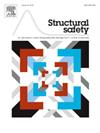Multi-point Bayesian active learning reliability analysis
IF 6.3
1区 工程技术
Q1 ENGINEERING, CIVIL
引用次数: 0
Abstract
This manuscript presents a novel Bayesian active learning reliability method integrating both Bayesian failure probability estimation and Bayesian decision-theoretic multi-point enrichment process. First, an epistemic uncertainty measure called integrated margin probability (IMP) is proposed as an upper bound for the mean absolute deviation of failure probability estimated by Kriging. Then, adhering to the Bayesian decision theory, a look-ahead learning function called multi-point stepwise margin reduction (MSMR) is defined to quantify the possible reduction of IMP brought by adding a batch of new samples in expectation. The cost-effective implementation of MSMR-based multi-point enrichment process is conducted by three key workarounds: (a) Thanks to analytical tractability of the inner integral, the MSMR reduces to a single integral. (b) The remaining single integral in the MSMR is numerically computed with the rational truncation of the quadrature set. (c) A heuristic treatment of maximizing the MSMR is devised to fastly select a batch of best next points per iteration, where the prescribed scheme or adaptive scheme is used to specify the batch size. The proposed method is tested on two benchmark examples and two dynamic reliability problems. The results indicate that the adaptive scheme in the MSMR gains a good balance between the computing resource consumption and the overall computational time. Then, the MSMR fairly outperforms those existing leaning functions and parallelization strategies in terms of the accuracy of failure probability estimate, the number of iterations, as well as the number of performance function evaluations, especially in complex dynamic reliability problems.
多点贝叶斯主动学习信度分析
本文提出了一种结合贝叶斯故障概率估计和贝叶斯决策理论多点富集过程的贝叶斯主动学习可靠性方法。首先,提出了一种称为积分边际概率(IMP)的认知不确定性测度作为Kriging估计的失效概率平均绝对偏差的上界。然后,根据贝叶斯决策理论,定义了一种称为多点逐步边际缩减(multi-point stepwise margin reduction, MSMR)的前瞻学习函数,量化在期望中加入一批新样本可能带来的IMP缩减量。基于MSMR的多点富集过程的经济有效实施是通过三个关键的解决方案进行的:(a)由于内部积分的分析可追溯性,MSMR减少到单个积分。(b)用正交集的有理截断对MSMR中剩余的单积分进行数值计算。(c)设计了最大化MSMR的启发式处理,以便每次迭代快速选择一批最佳下一个点,其中使用规定的方案或自适应方案来指定批大小。通过两个基准算例和两个动态可靠性问题对该方法进行了验证。结果表明,该自适应方案在计算资源消耗和总体计算时间之间取得了良好的平衡。在故障概率估计精度、迭代次数、性能函数评估次数等方面,MSMR算法明显优于现有的学习函数和并行化策略,特别是在复杂的动态可靠性问题中。
本文章由计算机程序翻译,如有差异,请以英文原文为准。
求助全文
约1分钟内获得全文
求助全文
来源期刊

Structural Safety
工程技术-工程:土木
CiteScore
11.30
自引率
8.60%
发文量
67
审稿时长
53 days
期刊介绍:
Structural Safety is an international journal devoted to integrated risk assessment for a wide range of constructed facilities such as buildings, bridges, earth structures, offshore facilities, dams, lifelines and nuclear structural systems. Its purpose is to foster communication about risk and reliability among technical disciplines involved in design and construction, and to enhance the use of risk management in the constructed environment
 求助内容:
求助内容: 应助结果提醒方式:
应助结果提醒方式:


